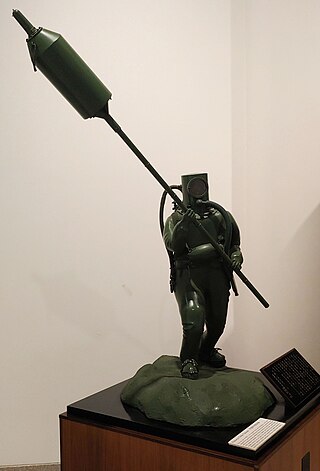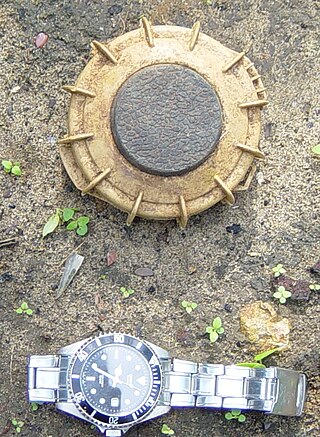
The Claymore mine is a directional anti-personnel mine developed for the United States Armed Forces. Its inventor, Norman MacLeod, named the mine after a large medieval Scottish sword. Unlike a conventional land mine, the Claymore may be command-detonated, and is directional, shooting a wide pattern of metal balls into a kill zone. The Claymore can also be activated by a booby-trap tripwire firing system for use in area denial operations.

Fukuryu were a part of the Japanese Special Attack Units prepared to resist the invasion of the Home islands by Allied forces. The name literally means "crouching dragon," and has also been called "suicide divers" or "kamikaze frogmen" in English texts.

The MON-50 is a Soviet rectangular, slightly concave, plastic bodied, directional type of anti-personnel mine designed to wound or kill by explosive fragmentation. It first entered service in 1965 and is a copy of the American M18 Claymore with a few differences. Its name is derived from Russian мина осколочная направленного, "directional fragmentation mine".

The MRUD is a Yugoslav design of plastic bodied, convex rectangular directional type anti-personnel mine designed to wound or kill by fragmentation. It is broadly similar to the M18A1 Claymore mine.

The MON-90 is a Claymore-shaped, plastic bodied, directional type of anti-personnel mine designed in the Soviet Union. It is designed to wound or kill by fragmentation. The mine is similar in appearance to the MON-50, but is approximately twice the size with a much greater depth.

The MON-100 is a circular, sheet metal bodied, directional type of anti-personnel mine designed and manufactured in the early 1960s by the Soviet Union. It is designed to wound or kill by fragmentation and resembles a large bowl.

An anti-personnel mine or anti-personnel landmine (APL) is a form of mine designed for use against humans, as opposed to an anti-tank mine, which target vehicles. APLs are classified into: blast mines and fragmentation mines; the latter may or may not be a bounding mine.

The PROM-1 is a Yugoslavian manufactured bounding anti-personnel mine. It consists of a cylindrical body with a pronged fuze inserted into the top of the mine. It is broadly similar in operation to the German S-mine.

The PMN series of blast anti-personnel mines were designed and manufactured in the Soviet Union. They are one of the most widely used and commonly found devices during demining operations. They are sometimes nicknamed "black widow" because of their dark casings.
The M7 is a small, metal-cased United States anti-tank blast mine that was used during the Second World War. It was based on the British Hawkins grenade. Approximately 2.5 million were produced before production ceased, and although it has long since been withdrawn from U.S. service, it can be found in Angola, Burma, Cambodia, Chad, Eritrea, Ethiopia, Korea, Lebanon, Myanmar, Somalia, Thailand, and Zambia.
The AT-8 or Cuban anti-tank mine is a square green plastic cased anti-tank mine. It is a scaled-up version of the Cuban anti-personnel mine. The mine consists of a plastic ribbed hinged upper case which rests on the fuzes placed into the lower plastic case. When enough pressure is placed on the upper lid the strikers are released from the fuzes. This triggers the main charge, which consists of up to twenty 400 g blocks of TNT. The mine is fitted with MUV or RO-1 type fuzes.
The FMK-1 is a small circular Argentina anti-personnel blast mine which, when fitted with a stiffened pressure plate, is also used as the fuze for the FMK-3 and FMK-5 anti-tank mines. The mine has a circular plastic body, with a number of small ribs running vertically around the outside of the mine, with the circular detonator and striker protruding on each side. The pressure plate has a distinctive six pointed star shape ribbing for stiffness. The bottom of the mine has small base plug inside which a small stud is installed. The stud increases the activation pressure of the mine. A metal detector disc can be added to the bottom of the mine, but it is not often used. It is actually in service with the Argentine Army.
The AUPS is a circular Italian bakelite cased minimum metal anti-personnel blast mine. The mine can be adapted with a steel fragmentation jacket and stake into a fragmentation stake mine. The mine is constructed in two halves, with the upper half containing the pressure fuse mechanism, the lower half contains the main charge and the detonator. The mine case is normally unpainted bakelite brown.
The Model 123 is a small Thai Claymore style directional anti-personnel mine. The mine has a square plastic main body with a convex front face marked with a triangle which is supported by two sets of scissor legs. Inside the main body is a layer of four hundred 5.5 millimeter steel ball bearings embedded in an RDX type explosive. The mine is normally used with an electrical detonator which is inserted into the top of the mine.
The Cardoen EC-2 mine is a Chilean directional fragmentation anti-personnel mine. It is broadly similar to the United States M18 Claymore mine.
The MMN-1 is a small Georgian Claymore type directional anti-personnel fragmentation mine. The mine projects fragments in a sixty degree horizontal arc to a casualty radius of 15 meters.
The MMN-2 is a Georgian Claymore type directional anti-personnel fragmentation mine. The mine projects fragments in a forty-five degree horizontal arc to a casualty radius of forty meters.

The SPG Kalina is a heavy, multi-purpose armoured personnel carrier designed at the OBRUM and is produced by the Bumar Łabędy company - part of Polish military consortium - Bumar Group. SPG is a development of the joint Poland, Soviet Union and East Germany transporter called MT-S, developed in the late 1980s.










